Blog
Adjustable Dumbbells vs Fixed Dumbbells: Which Dumbbell Set Should You Buy?
If you are setting up a new home gym, chances are you’re comparing adjustable dumbbells vs fixed dumbbells to decide which type is right for your setup. That’s what I’m going to help you figure out today. Unfortunately, there is no one-size-fits-all answer to this question. Because after all, fixed and adjustable dumbbells both serve very valid functions in the gym. It's just a matter of the following factors:
- Budget
- Space
- Other needs and preferences
I’ll discuss all three of the above items later in this article. But first, I’ll cover the basics that you need to know about adjustable dumbbells and fixed dumbbells, respectively:
Adjustable dumbbells
Adjustable dumbbells refer to a single pair of dumbbells, whose weight can be adjusted as needed to be heavier or lighter. The max weight, minimum weight, and weight increments depend on the particular set that you buy. Additionally, adjustment mechanism varies between different brands. You can divide the adjustment mechanism into two broad categories:
Plate-Loaded Adjustable Dumbbells
Plate-loaded adjustable dumbbells are adjusted by manually removing a locking mechanism, adding or removing plates, then re-securing the dumbbells by putting the locking back in place.
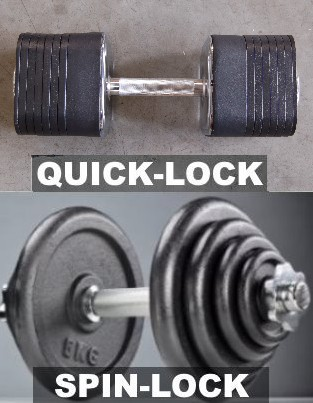
Now, it is important to note that within this category of plate-loaded adjustable dumbbells, there are MAJOR differences between the types of locking mechanisms that can make the difference between:
- A low-quality adjustable dumbbell set with subpar features, and ease of use issues that make adjustment an inefficient and tedious process
- A very high-quality adjustable dumbbell set with premium features, and intuitive ease of use that makes adjustment fast and easy.
I’ll give you an example of each of the two above-mentioned types of locking mechanisms:
Example #1: Low Quality = Spin-Lock Adjustable Dumbbells
Spin-lock dumbbells are the ones most people think of when they think of “adjustable dumbbells.” You’ll see them at any big box store like Dick’s Sporting Goods or Walmart.
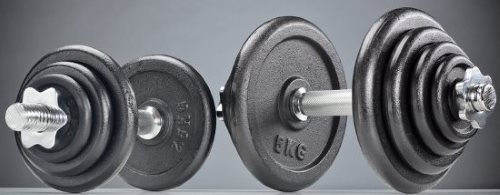
Although this very basic type of plate-loaded adjustable dumbbell set can get the job done for certain uses, they do have some major flaws:
The Plates Rattle
The spin-locks come loose during use. All it takes is a little bit of motion for the plates to rotate opposite the spin-locks from momentum, which will cause them to loosen ever so slightly. As soon as you lose a completely tight lock, the plates will shift back and forth, making noise, and giving a very noticeable feeling of instability during the exercise. I’m not saying the locks will spin all the way off the handle (unless the handle is at max capacity). However, the noise and instability of the shifting plates are a very noticeable negative point to consider.
Limited Max Capacity (Unless You Use Large-Diameter Plates):
Most spin-lock dumbbell handles are 14 inches long. Six inches of that the grip area. That leaves 4 inches of threaded area on each side. But when you account for the locks, which are about a half-inch each, you only have about 3.5 inches per side for weight plates. Technically, you could fill up this space with up to three 25 lb or 50 lb standard weight plates per side, which would give you a massive 155 to 305 lbs per dumbbell, BUT that would be ridiculous and impractical to the point of being useless because those plates are so tall that you couldn’t do any exercise. Not to mention, it starts to get pricey when you buy several of those heavier standard plates. You’re not saving money at that point, but you are getting a subpar solution. The 10 lb standard plates are the largest plates that are practical to use on spin-lock dumbbells in terms of size (not getting in the way) and price. You could fit four 10’s per side this way, for a max of just 85 lbs per dumbbell. Now, there are also longer spin-lock handles available. Sixteen-inch handles are the next most common, followed by 18-inch handles which are much rarer. These would let you get into the low 100s in terms of max weight capacity. However, as discussed below, this comes with other issues...
NOT Compact
The spin-lock dumbbells are always as long as the length of the threaded handle. This is usually 14-16 inches long, rarely 18+ inches. So, regardless of if you’re using 10 lbs or 100 lbs, it’s still 14+ inches long. This becomes a major hindrance on exercises like dumbbell curls or lateral raises because the ends of the handles knock into your sides.
Circular Plates
The plates on spin-lock dumbbells are circular. This isn’t really a big deal, but it’s still a negative, at least in my opinion. When it comes to dumbbells, there’s really no functional advantage to having round plates, other than maybe the ability to roll from point A to point B. However, I only find this to be an annoyance since you have to deal with the dumbbells rolling away from the position you set them if the floor is even slightly uneven.
Can’t Balance Ends of Dumbbells on Thighs
If you do any dumbbell variation of the bench press or seated shoulder press, then the inability to stand the dumbbells up vertically on your thighs is a major negative. If you want to safely and efficiently do perform these exercises with heavier amounts of weight, then you need to be able to start the exercise by having the dumbbell ends on your thighs. This way, you’re able to “kick” the weights back and up toward your shoulder to get them into place for the pressing motion. However, unless the spin-lock dumbbells are filled all the way to the end of the handle, then you will have the 1-inch diameter handle jamming into your thigh, causing pain and making it difficult if not impossible to rest the weight there.
Example #2: High Quality = Ironmaster Quick-Lock Adjustable Dumbbells
I bought a pair of Ironmaster Quick-Lock adjustable dumbbells 7 years ago after much research and deliberation. These were arguably the best adjustable dumbbells on the market then, and that’s still the case today. I wrote about them in detail in my Ironmaster adjustable dumbbells review, which I recommend checking out if you want to hear my complete in-depth analysis.
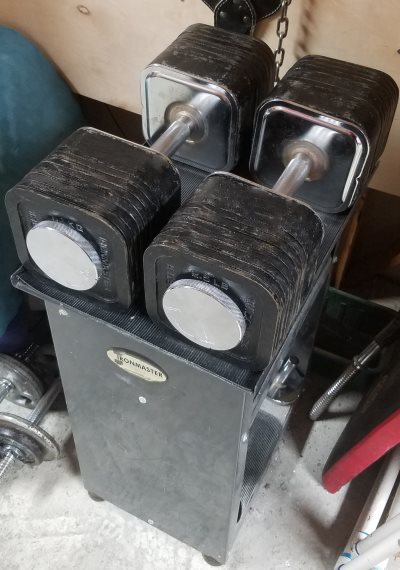
For the purpose of this article, I want to talk about the Ironmasters because they are the benchmark example for a high-quality plate-loaded adjustable dumbbell set. Below, I’ll cover each of their stand-out features, and discuss how and why they are so easy to adjust and train with, especially in comparison to spin-lock dumbbells discussed previously.
Quiet and Secure
The Ironmaster adjustable dumbbells do not rattle at all. The quick-lock pin locks tightly and stays that way throughout the lift. Plus, the plates interlock onto each other, which gives an additional amount of security in terms of preventing plate-on-plate movement Quick and Easy Adjustment The Ironmaster’s are so easy to adjust because of 3 things:
- Their patented “quick-lock” system, which includes partially threaded pins. They simply need to be inserted and turned ¼ -½ rotation to lock them in place. To take them out, you just do the opposite. The plates lock up tightly.
- The plates are all the same size in terms of height and width, which makes it easy to pick up and move multiple plates at the same time.
- All of the plates also interlock together, and onto the end of the dumbbell handle. This makes the plates “stackable,” which makes them easier to handle so you can add or remove multiple plates faster and with greater ease.
Compact and Scalable in Size
The Ironmasters are compact in size. They are 6.7 inches tall by 6.7 inches wide, at all weights. And the length of the dumbbells scales up as the weight gets higher. So even as you add more plates and the length increases, they are still compact for their weight. Specifically, the Ironmaster’s length ranges from:
- ~7 inches in length at 5 lbs (just the handle, no weights, no pins), to...
- 14.5” at 75 lbs, to...
- 18.5” at 120 lbs, to…
- 23.5” at 165 lbs

Compare this to spinlock dumbbells and some selectorized dumbbells. They are the same length at their minimum weight as they are at their maximum weight. As covered earlier, this is 14-18 inches for spin-lock dumbbells and up to 18 or so inches for selectorized models with the dial adjustment mechanism.
Square Plates (Won’t Roll Away)
As mentioned earlier, I don’t like circular dumbbells because they roll away on uneven surfaces. Hex dumbbells fix that problem. And of course, so do the square plates that are unique to Ironmaster.
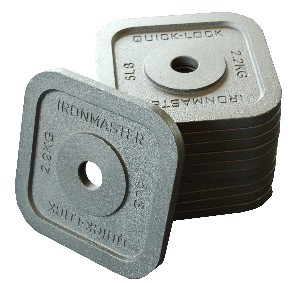
However, the square plates have an advantage over the hex dumbbell shape: They are significantly more stable when doing exercises that involve grasping the handles while the dumbbells are on the floor. Examples include:
- Dumbbell Push-Ups
- Dumbbell Incline Push-Ups
- Renegade Rows
- Dumbbell Planche Variations
- Dumbbell V-Sits
- Dumbbell Plank Rotation
You can do these exercises with hex dumbbells. But, you won’t be as stable and the dumbbell may roll over if you’re using a lighter weight and aren’t careful.
Very High Max Capacity
With the Ironmasters, you are able to add a ton of weight. More than the vast majority of lifters would ever need on a dumbbell.

Specifically, this is done with the use of “add-on” kits. It’s a pretty simple concept: Each add-on kit includes more weight plates and a longer pin:
- 120 lb add-on kit: This includes four longer locking screws and four 22.5 lb weight plates. It requires already having the 75 lb dumbbell set.
- 165 lb add-on kit: This includes four even longer locking screws and four additional 22.5 weight plates. It requires having the 75 lb dumbbell set as well as the 120 lb add-on kit. It should be noted that the pins in this kit are different in that they’re fully threaded instead of partially threaded. This is required for extra security at these very high weights.
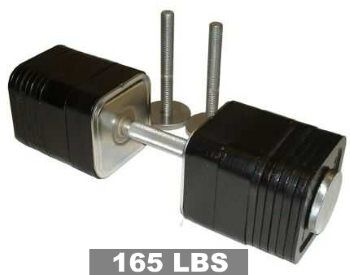
As mentioned earlier, as the weight increases, the only other dimension that increases is the dumbbell’s length. The plates do not get taller or wider than the original 6.7” x 6.7” square size. NOTE: There is also a 75 lb “Quick-Lock Dumbbell Upgrade kit.” This is a bit different than the “add-on” kit because it doesn’t have any quick-lock pins. You would only buy this one if you have the 45 lb Quick-Lock dumbbell set (without the stand) and wanted to increase it to a max capacity of 75 lbs. You don’t need any extra pins because the pins used on the 45 lb set will also work all the way up to the 75 lb weight.
Selectorized Adjustable Dumbbells
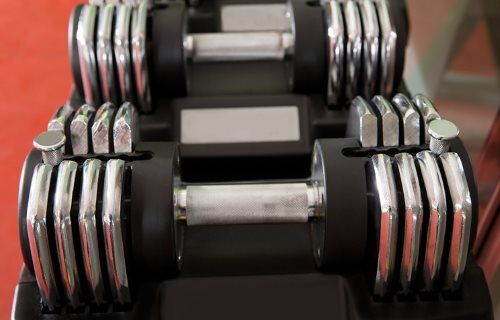
Selectorized dumbbells come in different designs, but the concept behind them is similar. You simply select a weight by:
- turning a knob or dial, or…
- moving a pin up or down in a weight stack
There is one clear advantage to this category of adjustable dumbbells over the plate-loaded type: They are significantly faster to adjust. This is no doubt a major selling point and some lifters will value it over other factors. However, there are a few notable ways in which selectorized dumbbells can fall short in other areas:
Less Durable
Selectorized adjustable dumbbells are more prone to damage from drops than plate-loaded adjustable dumbbells. This is because they necessarily have a more intricate weight adjustment mechanism. In the case of the selectorized dumbbells that use a dial to adjust weight, this means there are several extra small parts, including many made of plastic. That’s not a good recipe for longevity. There are other, more durable selectorized dumbbells, such as those with different sized weight cages/brackets that stack inside each other and use a pin to adjust the weight stack. Because of the simpler design with no small plastic parts to worry about, these are significantly more durable. However, they’re still more prone to damage than a high-quality plate-loaded dumbbell set, since the weight cages/brackets can bend if dropped too hard. In my view, the reduced durability is the biggest negative trade-off that comes with faster adjustment. So if you want this kind of dumbbell, you just have to remember to be extra careful when handling them.
Unnatural Dumbbell Look and Feel
All selectorized dumbbells will either look or feel different than a regular dumbbell. For example, some models will have supports around the handle, which box-in your wrist. This may limit your range of motion on some lifts or prevent you from grasping the handle in certain ways. The selectorized dumbbells with the dial adjustment mechanism will have gaps between some weight plates, depending on which weight is selected (e.g. there might be a 10 lb plate, followed by a couple of empty slots, followed by a 2.5 plate). This is a visual issue only though; not a functional one. Additionally, all of the decent selectorized dumbbells I’ve seen do not have a raw iron handle with knurling on it for grip. Instead, they have some type of rubber. There are some that do have the metal handles, but they either have a very low max weight capacity, or they fall so short in terms of overall quality that they’re not even worth considering.
Handle Length Is Too Long on Some Models
All of the selectorized dumbbell models that use a turnable dial mechanism for adjustment have this one major issue. That is, the total length of the dumbbell is the same regardless of if you’re using 5 lbs or the maximum capacity. This is the same issue as with the spin-lock dumbbells, which I discussed earlier. With both dumbbell designs, you’re stuck with whatever the length of the handle is. For selectorized dumbbells with dial adjustment, this is usually between 16 to 18 inches. That is long enough to get in your way on curls, lateral raises, and other exercises. This isn’t the end of the world, but it’s still a negative point to consider.
Fixed Dumbbells
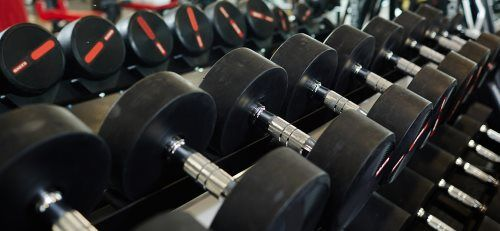
There are different types of fixed dumbbells out there. Some have dumbbell ends that are circular, as shown in the image above. Others have the classic “hex” dumbbell shape, shown below:
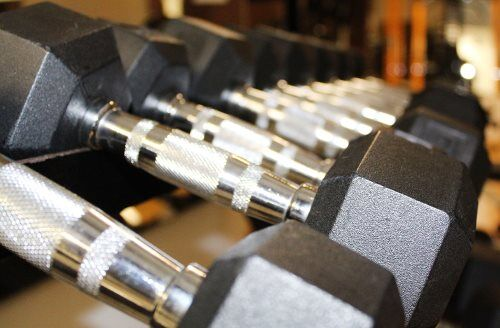
Even more uniquely, some are square, like the Ironmaster fixed dumbbells, shown below:
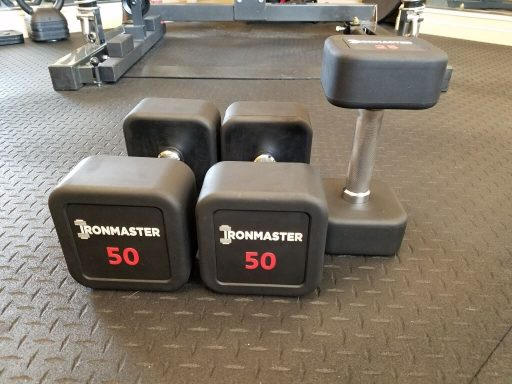
Another major difference between the different types of fixed dumbbells is whether or not dumbbell ends have any type of rubber coating (e.g. urethane, neoprene). The higher quality dumbbells will be rubber-coated, while the less expensive fixed dumbbells will be bare. The rubber coating serves a protective function in the event that the dumbbell is dropped: It protects the dumbbell itself, the floor, and your feet or hands if they get in the way. Regardless of the specific features of a given set of fixed dumbbells, they are, as a category, pretty awesome. I’ll explain why in the following sections.
Grab and Go
With fixed dumbbells, there’s absolutely ZERO time needed to adjust. Because – duh! – fixed dumbbells by definition don’t adjust. Each dumbbell is a fixed weight! As such, fixed dumbbells are by far the most efficient type of dumbbell set for fast, efficient, and completely uninterrupted training sessions. Of course, it’s not like adjusting dumbbells is a difficult or a major hindrance to your workout flow. But it is one more thing you have to think about and do between sets. If you have a completely fixed dumbbell set, then you can focus 100% on what you’re doing: intense dumbbell training.
Instant Supersets and Drop Sets
If doing supersets or drop sets is an integral part of your training, then you should strongly consider getting fixed dumbbells instead of adjustable dumbbells. If you use either of these training techniques, then you know that the key to doing them correctly is the ability to switch from one amount of weight to another, as fast as possible. Especially in the case of drop sets. With fixed dumbbells, you will have no delay.
Compact and Scalable in Size
Each fixed dumbbell is made to be compact for its size. It’s no longer or bigger than it needs to be for its weight. As fixed dumbbells get heavier, they get proportionally larger in size. Sometimes this means that the dumbbell ends simply increase in length, and the diameter of the dumbbell end remains the same whether it’s a 5 lb or a 95 lb dumbbell. However, with other fixed dumbbell sets, the diameter of the dumbbell ends also increases somewhat as the weight gets heavier; though never to a size that’s too large or awkward to handle.
More Durable
The fact of the matter is that even the most rugged adjustable dumbbells aren’t as durable as any decent set of fixed dumbbells. This is because all adjustable dumbbells have multiple components that are designed to be removed. Whereas, fixed dumbbells are either:
- Completely molded/welded into one solid block, or…
- If they have multiple components, they are permanently secured by very strong bolts or other hardware.
So, the chances they’ll be damaged from rough use are significantly less than with adjustable dumbbells.
Fixed Dumbbells Are Awesome but Expensive
In an ideal world, everyone would get a fixed dumbbell set. They offer better overall durability, longevity, convenience, and ease of use, compared to adjustable dumbbells. However, as I’ll discuss in the next sections, a fixed dumbbell set is sometimes an inaccessible option due to budget and/or space restrictions.
What to Consider When Deciding Between Adjustable vs Fixed Dumbbells
Budget
It’s no secret that fixed dumbbells are going to cost you significantly more than any adjustable dumbbell set. Think about it: Let’s say you have the basic 75 lb Ironmaster Quick-Lock adjustable dumbbell set that lets you adjust anywhere from 5 to 75 lbs. This will cost you $589 (at the time of writing this). Technically, you can adjust in increments of 2.5 lbs, but for this example, lets just use 5 lb increments, since it will be easier to compare to a comparable fixed dumbbell set because fixed dumbbells go up in 5 lb increments… ...So, using just 5 lb increments, the Ironmaster Quick-Lock dumbbells give you the equivalent of 15 pairs of dumbbells (again, I’m using 5 lb increments for this example; you’d really get the equivalent of 30 pairs since you can add weight in 2.5 increments). In other words, the Ironmaster adjustable dumbbells would replace 1200 lbs worth of fixed dumbbells (2 x [5+10+15+20+25+30+35+40+45+50+55+60+65+70+75] = 1200). What does this mean in terms of budget? Well, if you assume that new dumbbells usually cost around $1.25 per pound (give or take), then the 15 pairs of fixed dumbbells ranging from 5 to 75 lbs will cost $1500 (1200 x 1.25 = 1500). You should probably factor in a dumbbell storage rack, which will probably cost at least an extra $200-300. Clearly, this is far from being a budget-friendly option for your average home gym lifter. However, if you want them and are in the financial position to afford them, then they are an excellent value for you.
Space
The amount of free space you have available in your training area is a major consideration in determining which type of dumbbell is right for you -- or more accurately, which (if any) type is wrong for you. Specifically, if you have an already small area for your home gym, then you should probably avoid a fixed dumbbell set in favor of adjustable dumbbells. This is because a good fixed dumbbell set will take up several cubic feet of storage, even if stored neatly in a rack. When you’re already tight on space, every bit of space counts. If you get an adjustable dumbbell set, you could save most of that space:
- as an area to perform exercises in, or…
- to install or store different pieces of equipment that let you do more and different types of movements
If you have plenty of space to spare in your home gym, then that doesn’t exclude fixed dumbbells or adjustable dumbbells. You’ll have to decide based on budget (see above) and other needs and preferences (see below).
Other Needs & Preferences
Your needs and preferences are major considerations when deciding between adjustable vs fixed dumbbells. Here are some of the most common examples of different needs and preferences that would affect your decision:
- If the ability to do supersets or drop sets with no delay is essential, then fixed dumbbells are the way to go.
- If maximum convenience is very important to you, then fixed dumbbells are a better choice.
- If you often workout with one or more training partners in your home gym, then fixed dumbbells may be the better solution. This way, multiple people can do dumbbell exercises at the same time. And you guys don’t have to adjust the weight each time you switch dumbbells from one person to another.
- If you’re a personal trainer who travels to clients, then adjustable dumbbells are a must, because of their portability.
- If you’re buying dumbbells for use in a commercial gym, then you should go with a fixed dumbbell system. Any of the various parts and pieces in any adjustable dumbbell set are bound to get lost or damaged when used by a bunch of different people. Not to mention, you can only have one person using the dumbbells at a time. The only scenario when adjustable dumbbells would be appropriate in a commercial gym setting is if it is a very small, private commercial gym with responsible and respectful lifters who will treat the equipment with care and put things back where they belong.
The above are just recommendations, and they assume all other deciding factors are neutral. In reality, you also have to weigh these needs and preferences against your budget and space requirements, as discussed in an earlier section of this article.
Conclusion
To recap, after reading this guide, you should now be able to:
- Understand the key differences within the two broad categories of adjustable dumbbells and fixed dumbbells:
- Adjustable DB differences: Plate loaded with high quality locking mechanism, plate loaded spin-lock style mechanism, selectorized mechanism
- Fixed DB differences: Circular, hex or square dumbbell ends, rubber coated or non-coated dumbbell ends.
- Understand the key differences between these two broad categories of adjustable dumbbells and fixed dumbbells:
- Adjustable DBs: Cost less and take up less space; but they do require some amount of time to adjust when needed and are somewhat less durable.
- Fixed DBs: Cost significantly more and take up a lot more space; but they are very durable and extremely convenient (i.e. just pick it up and lift; no time needed to adjust)
- Know what factors to consider when deciding:
- Budget
- Available space
- Needs and preferences
One thing to remember – for whichever type of dumbbell you buy – is that you can start small and build your way up to a heavier capacity for adjustable dumbbells or larger collection of fixed dumbbells. This is a good solution if your budget doesn’t cover the dumbbell set you want. For example, if you want fixed dumbbells, you can start with a 5-50 lb set to begin with. Then once you have more cash in the future, you can spring for the 50-100 lb set, and so on. Same with adjustable dumbbells. Let’s say you ideally want the Ironmaster Quick-Lock Dumbbells that go up to 120 lbs, but it’s a little out of your budget. Well, you can just get the base 75 lb. set first. Then after you’ve saved some more money, you can buy the 120 lb add-on kit. That’s what I did when I bought my set 7 years ago. Whichever dumbbells you end up buying, be sure to get the most out of them by training hard, being safe, and taking care of them to maximize their longevity.
Alex V. is the author of King of the Gym, a weight training blog for anyone looking to get stronger and look better. He seeks to thoroughly explain essential training and nutrition topics in a way that the average lifter can understand. He also has a passion for discussing all types of home gym equipment including adjustable dumbbells like the Ironmasters!


No Comments Yet